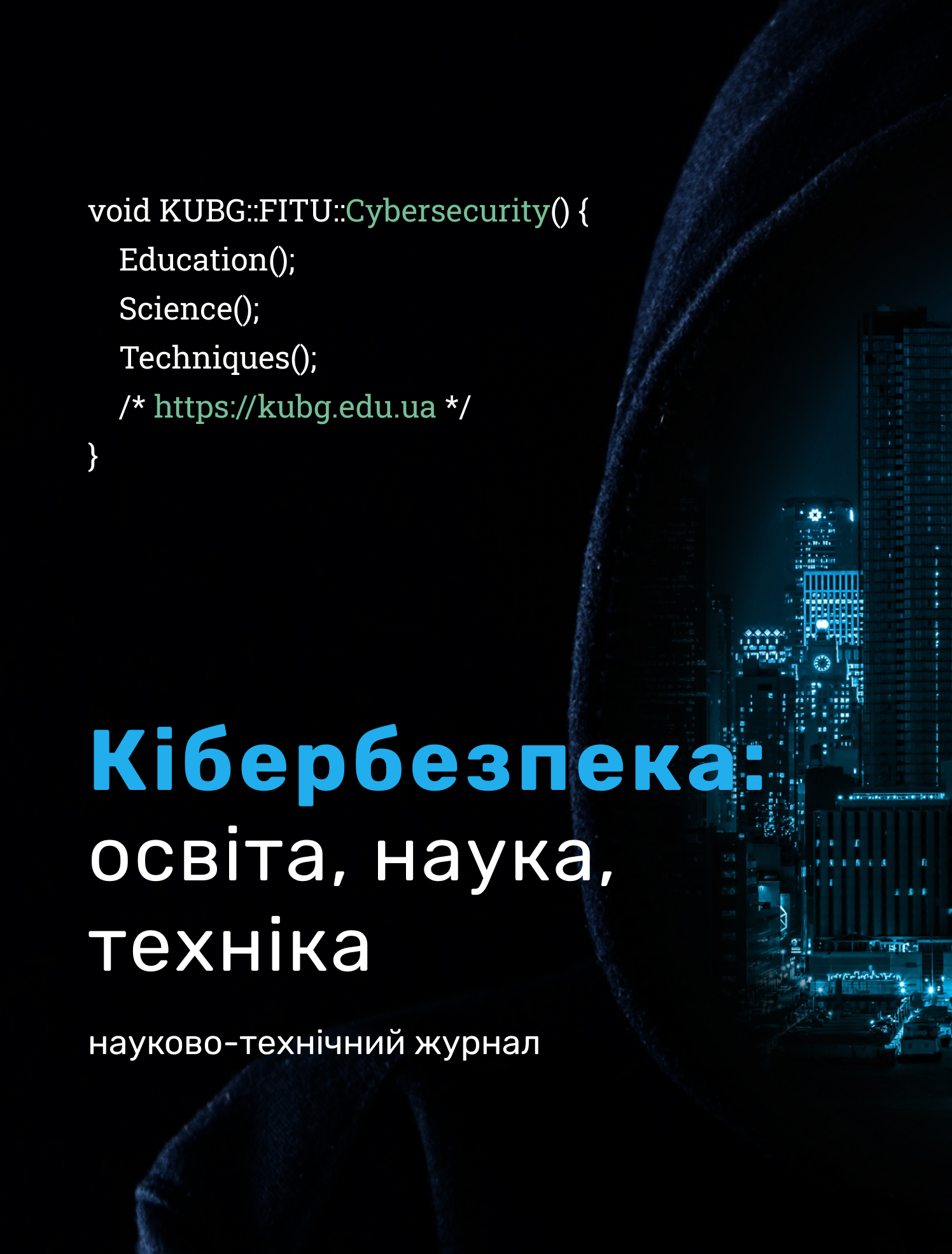ДОСЛІДЖЕННЯ МЕТОДІВ АНАЛІЗУ ТА МОДЕЛЮВАННЯ ДЖЕРЕЛ РЕБ З УРАХУВАННЯМ ПРОСТОРОВО-ЧАСТОТНОГО ОРІЄНТУВАННЯ
DOI:
https://doi.org/10.28925/2663-4023.2025.30.950Ключові слова:
радіоелектронна боротьба, просторово-частотне орієнтування, аналіз сигналів, моделювання джерел, методи локалізації, протидія РЕБ.Анотація
У статті розглянуто сучасні підходи до аналізу та моделювання джерел радіоелектронної боротьби (РЕБ) із урахуванням просторово-частотного орієнтування. Показано, що розвиток засобів РЕБ суттєво змінює характер сучасних збройних конфліктів, створюючи умови, за яких класичні методи виявлення та протидії сигналам завад втрачають ефективність. У зв’язку з цим актуальним є застосування методів, що дозволяють комплексно оцінювати як частотні, так і просторові характеристики електромагнітних випромінювань. Проаналізовано основні напрями розвитку методів спектрального, статистичного та просторового аналізу, включаючи високороздільні алгоритми (MUSIC, ESPRIT), методи часово-частотних перетворень, а також моделі, що враховують багатопроменевість та динамічні зміни середовища. Окрему увагу приділено підходам до моделювання джерел РЕБ, що дозволяють формувати математичні та імітаційні моделі з урахуванням широкосмуговості, адаптивності та складної структури сигналів. Результати дослідження свідчать, що інтеграція просторово-частотного аналізу із сучасними методами обробки сигналів та інтелектуальними системами забезпечує підвищення ефективності виявлення, ідентифікації та нейтралізації джерел РЕБ. Отримані висновки можуть бути використані для вдосконалення алгоритмів функціонування засобів ураження та створення нових концепцій протидії у сфері радіоелектронної боротьби.
Завантаження
Посилання
Sokolov, V., Skladannyi, P., & Platonenko, A. (2022). Video channel suppression method of unmanned aerial vehicles. In 2022 IEEE 41st International Conference on Electronics and Nanotechnology (ELNANO) (pp. 473–477). IEEE. https://doi.org/10.1109/ELNANO54667.2022.9927105
Sokolov, V., Skladannyi, P., & Platonenko, A. (2023). Jump-stay jamming attack on Wi-Fi systems. In 2023 IEEE 18th International Conference on Computer Science and Information Technologies (CSIT) (pp. 1–5). IEEE. https://doi.org/10.1109/CSIT61576.2023.10324031
Sokolov, V., Skladannyi, P., & Korshun, N. (2023). ZigBee network resistance to jamming attacks. In 2023 IEEE 6th International Conference on Information and Telecommunication Technologies and Radio Electronics (UkrMiCo) (pp. 161–165). IEEE. https://doi.org/10.1109/UkrMiCo61577.2023.10380360
Sokolov, V., Skladannyi, P., & Astapenya, V. (2023). Bluetooth low-energy beacon resistance to jamming attack. In 2023 IEEE 13th International Conference on Electronics and Information Technologies (ELIT) (pp. 270–274). IEEE. https://doi.org/10.1109/ELIT61488.2023.10310815
Sokolov, V., Skladannyi, P., & Mazur, N. (2023). Wi-Fi repeater influence on wireless access. In 2023 IEEE 5th International Conference on Advanced Information and Communication Technologies (AICT) (pp. 33–36). IEEE. https://doi.org/10.1109/AICT61584.2023.10452421
Sokolov, V., Skladannyi, P., & Astapenya, V. (2023). Wi-Fi interference resistance to jamming attack. In 2023 IEEE 5th International Conference on Advanced Information and Communication Technologies (AICT) (pp. 1–4). IEEE. https://doi.org/10.1109/AICT61584.2023.10452687
Haykin, S. (2014). Communication Systems. Wiley. https://www.wiley.com/en-us/Communication+Systems%2C+5th+Edition-p-9780471697909
Sklar, B. (2001). Digital Communications: Fundamentals and Applications. Prentice Hall. https://www.pearson.com/en-us/subject-catalog/p/digital-communications-fundamentals-and-applications/P200000003353/
Van Trees, H. L. (2004). Detection, Estimation, and Modulation Theory. Wiley. https://www.wiley.com/en-us/Detection%2C+Estimation%2C+and+Modulation+Theory%2C+Part+I%2C+Detection%2C+Estimation%2C+and+Linear+Modulation-p-9780471222027
Schmidt, R. (1986). Multiple emitter location and signal parameter estimation. IEEE Transactions on Antennas and Propagation, 34(3), 276–280. https://doi.org/10.1109/TAP.1986.1143830
Roy, R., & Kailath, T. (1989). ESPRIT — Estimation of Signal Parameters via Rotational Invariance Techniques. IEEE Transactions on Acoustics, Speech, and Signal Processing, 37(7), 984–995. https://doi.org/10.1109/29.32276
Krim, H., & Viberg, M. (1996). Two decades of array signal processing research: The parametric approach. IEEE Signal Processing Magazine, 13(4), 67–94. https://doi.org/10.1109/79.534070
Mallat, S. (2008). A Wavelet Tour of Signal Processing. Academic Press. https://www.elsevier.com/books/a-wavelet-tour-of-signal-processing/mallat/978-0-12-374370-1
Cohen, L. (1995). Time-Frequency Analysis. Prentice Hall. https://www.pearson.com/en-us/subject-catalog/p/time-frequency-analysis/P200000003342/
Nakonechnyi, Y. M., & Bybyk, R. T. (2020). Methods of signal analysis in electronic warfare systems. Lviv: Lviv Polytechnic National University. https://science.lpnu.ua/csn/all-volumes-and-issues/volume-7-number-1-2025/research-of-existing-methods-for-determining-spatial-and-frequency-parameters-of-electronic-warfare-ew-sources
Pawlak, M. (2018). Modelling and simulation of electromagnetic interference sources. Military Communications Review. https://www.researchgate.net/publication/327123456_Modelling_and_Simulation_of_Electromagnetic_Interference_Sources
Zeng, Y., & Zhang, R. (2015). Wireless information and power transfer: From theory to practice. IEEE Communications Magazine, 53(1), 104–110. https://doi.org/10.1109/MCOM.2015.7010537
Li, J., & Stoica, P. (2008). MIMO Radar Signal Processing. Wiley. https://www.wiley.com/en-us/MIMO+Radar+Signal+Processing-p-9780470170935
Wang, X., & Chen, Y. (2021). Spatial-frequency joint processing for source localization in complex environments. Signal Processing Journal, 182, 107931. https://doi.org/10.1016/j.sigpro.2021.107931
Bishop, C. M. (2006). Pattern Recognition and Machine Learning. Springer. https://www.springer.com/gp/book/9780387310732
Goodfellow, I., Bengio, Y., & Courville, A. (2016). Deep Learning. MIT Press. https://www.deeplearningbook.org/
Zhang, X., & Liu, W. (2022). AI-based signal recognition for electronic warfare applications. IEEE Access, 10, 34567–34578. https://doi.org/10.1109/ACCESS.2022.3174567
Опубліковано
Як цитувати
Номер
Розділ
Ліцензія
Авторське право (c) 2025 Роман Бибик, Іван Опірський

Ця робота ліцензується відповідно до Creative Commons Attribution-NonCommercial-ShareAlike 4.0 International License.




